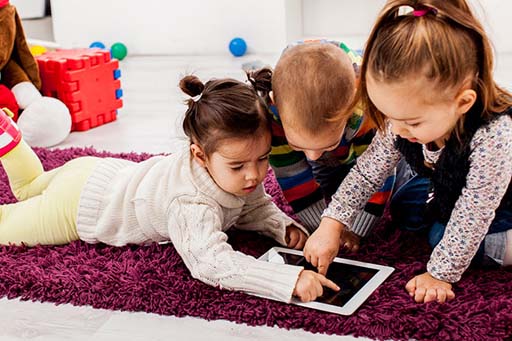1.1 From zero to eight
It’s difficult to ignore the rapid rate at which young children’s access to technology is growing, especially with the introduction of tablets, smartphones, touchscreen devices and access to the internet. This sudden increase in the adoption of technology applies to younger and older children alike.
National surveys from across the world (for example Ofcom Media Use Report in the UK, Common Sense Media Survey in the USA or Roy Morgan Young Australians Survey in Australia) show that increasingly younger children are using digital technology more often. The most popular device among young and old is a smartphone. In Canada, 23.5 per cent of youth aged 8–10 have their own smartphone (Hong and Craig, 2018). Figures published by the NSPCC in the UK show smartphone ownership increasing with age (20 per cent of 8–11-year-olds and 65 per cent of 12–15-year-olds) (Jütte et al., 2014). The EU Kids Online Network project, called Zero to Eight, illustrates just how pervasive technology is becoming for younger children. The project report identified a significant increase over the previous five years of children under nine years old using the internet (Holloway et al., 2013). In particular it noted a growing trend for very young children (pre-schoolers) to use tablets and smartphones to access the internet. In the USA, 8–12-year-olds were found to be spending on average 4 hours 44 minutes using screens (excluding screens used at school or for homework) and between 2015 and 2019, daily computer use for homework or watching videos online has doubled.
There is no doubt that children are now going online at younger ages, and Professor Sonia Livingstone, a lead researcher in children’s internet use, has warned that often their ‘lack of technical, critical and social skills may pose [a greater] risk’ (Livingstone et al., 2011, p. 3).
Children connect with their peers with TikTok, the leading destination for short-form mobile video, as well as YouTube, Snapchat and Instagram, which are the most popular platforms among teens (Pew Research Centre, 2018). Different platforms come with different designs, purposes and traditions of use. While there is a tendency to group all these different platforms under the umbrella term ‘screen time’, researchers point out that the idea of screen time is misguided as it muddles the nuanced conversations we need to have about children and different forms and functions of technology use (Kucirkova and Livingstone, 2017).
While many parents are concerned about ‘screens’ in general damaging their children’s sleep, health or friendships, it is better to think about the different activities in terms of content, context and the child. Researchers still know very little about the complex relationships between these ‘3Cs’. The issue is therefore not simply about banning technology or allowing free use of screens. The challenge for parents is how best to understand and manage the risks alongside the benefits, in relation to the context in which they are used, the content of the activity and the potential impact for individual children; these are the issues discussed in this course.
To get an insight into how research in this area progresses over time you may like to read an extract from Holloway et al., 2013 [Tip: hold Ctrl and click a link to open it in a new tab. (Hide tip)] and compare it with the latest findings from the project Global Kids Online tracking children’s internet use across the world.

